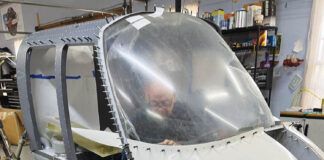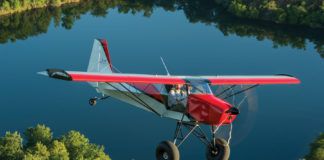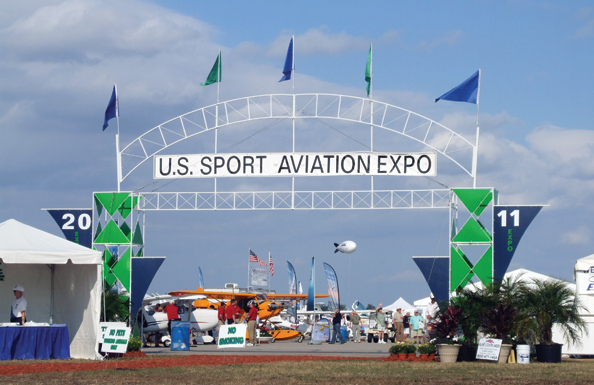
In early 2004, as retired U.S. Army officer Bob Wood and other volunteers including Phil Lockwood of Lockwood Aviation Supply planned a first national showcase event for Light Sport Aircraft (LSAs) and Sport Pilots, the new categories did not officially exist. Rules for the entry-level pilot license and for the aircraft they would be allowed to fly were largely complete, but only a few new aircraft were FAA-qualified, and the Sport Pilot license wouldn’t become effective until September 2004.
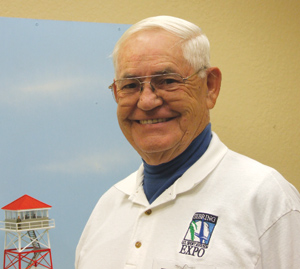
Bob Wood has directed each of the seven Sebring shows, and he plans to continue in the volunteer job for at least the next few years.
Despite the thousands of hours invested by several hundred volunteers who formulated the LSA rules under ASTM organizational guidance, the new programs appeared to be met with equal measures of enthusiasm and skepticism, which had also followed a failed earlier attempt by the FAA to simplify entry-level aviation.
In contrast to established nationally known aviation events, Wood’s group envisioned a new kind of airshow at their home field, Sebring Regional Airport in central Florida. Theirs would be neither a fly-in nor an entertainment spectacle: no aircraft camping and no aerobatic demonstrations. Instead, the Sebring show-officially named the U.S. Sport Aviation Expo-would seek manufacturers and LSA retailers, purveyors of related goods and services, and-most important-potential pilot customers intent on flying before buying. If it succeeded, the Sebring event would concentrate on demo flying rather than making it difficult or impossible as at other sport aviation airshows.
The premier event occurred in the fall of 2004. Weather always plays a big role, and the fall 2005 version was postponed to January of 2006 by a trio of hurricanes that hit central Florida in a six-week period. Folks liked the January timing, however, and it became standard.
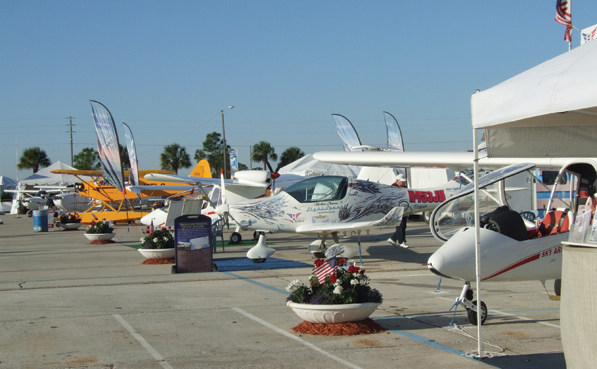
Here’s the lineup near the main gate. Hey! What’s that four-seat Cessna doing in there?
What’s New
This year’s four-day Expo began on Thursday, January 20. As always, new products were displayed and some seen previously disappeared. The German-made Flight Design CTLS was seen and flown at Expo ’10, but this year one on amphibious Clamar floats grabbed attention, as did a Legend Cub also on floats. Other highly visible first-timers were the carbon-fiber Czech Republic Phoenix motorglider imported by Jim Lee, and the Criquet Aviation USA Storch. All three aircraft are licensed in the Special Light Sport Aircraft (SLSA) factory-built category. I flew these three aircraft briefly and will comment on them shortly.
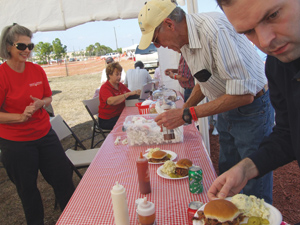
The Highland County Cattle Women always dish out a great lunch that also beefs up their scholarship fund.
In the soon-to-disappear category was the Czech Republic Piper Sport, formerly known as the Sport Cruiser. The beautifully flying Piper Sport was last year’s big Sebring debut, but the marriage was short-lived. Piper took orders for 71 Piper Sports, delivered 47, and says the remaining contracts will be honored. Following the official divorce, the same airplane minus Piper logos will revert to American sales and service by Don Ayres’ group, which was also the importer for Piper. The aircraft will take back its maiden name of Sport Cruiser.
Airport flight procedures were also new this year. For the first time, FAA controllers (12 of them, all from Orlando) manned the tower (no female controllers were in sight) for the event. Previously, a separate runway for LSAs and ultralights allowed flight ops whenever the green flag was up, which was most of the time except for during high wind, other bad weather or lunchtime for the volunteer paddle-equipped aircraft-guidance crew. This year, powered parachutes dominated ops until 9 a.m. each day, at which time the FAA opened the tower for business.
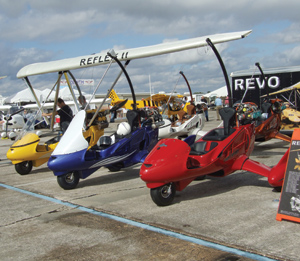
Local color. Revo and other trikes (powered hang gliders) were plentiful this year.
New to the forums area this year was one led by Richard Gersh from Terrafugia with its flying car that began as an MIT postgraduate student project. Photos plus a model in the exhibitors’ tent revealed a new twin-boom tail on the production version. The original single-tail prototype has been flown, and two new-configuration test airplanes were being built. The FAA has been highly cooperative in the development phase, including a waiver to raise the weight based on required automotive safety systems, Gersh said. The federal highway safety folks have also approved the concept as a car, even suggesting road registration in the multi-purpose vehicle category to avoid the need for a heavy front bumper. The schedule-currently on track-calls for first customer deliveries late this year. As of January, Terrafugia had nearly 100 $10,000 refundable deposits; the money is in an account not being spent, Gersh said. A U.S. military concept and development agency, DARPA, has awarded Terrafugia a contract to help develop an air-convertible helicopter/airplane to transport four fully equipped Marine Corps troops into battle-without a pilot aboard the aircraft. The Terrafugia flying car (labeled a roadable airplane by the company until it hired a marketeer) is expected to sell for $220,000 to $250,000.
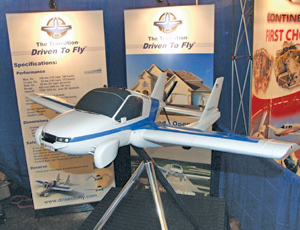
Forums included an update on the Terrafugia flying car. The model shows its new twin tailboom configuration.
Kevin Kerwin from California showed off his beautiful new single-seat Composite X helicopter with its 50-hp Mosquito engine. A Solar turbine engine is an option. Adding inflatable floats provides weight credit that moves this heli into the ultralight category. Kerwin plans to take helicopter flight instruction to the solo point and then practice in his machine, which he helped build at the factory in Trenton, Florida.
The Hansen Group from San Diego, which imports several SLSAs including the Italian Sky Arrow, displayed its three-days-off-the-boat convertible Polish FK 12 Comet biplane. Like the Warner Aircraft Sportster tandem two-seater, the swept-wing FK 12 LSA allows flying in how-you-feel-today cockpit configuration. How about aft seat only (front pit covered) with either a windshield or an enclosed bubble canopy, two seat enclosed with a single bubble canopy or two pits, each with its own windshield? Construction includes welded steel and aluminum tubes, Ceconite-covered carbon-fiber wing parts and fuselage panels, and sheet aluminum Ceconite-covered flaperons. I should have looked for wood stick grips.
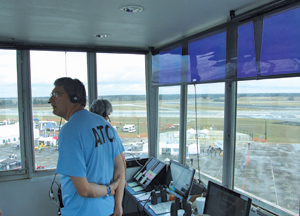
A dozen FAA controllers from Orlando staffed the temporary tower, the FAA’s first ATC involvement with the Sebring event.
Product Sampling
Flight No. 1. Three years ago at Sebring I flew with Jim Lee in his Lambada motorglider. No longer available, it’s been replaced by the Phoenix, a higher performance carbon-fiber motorglider from another Czech Republic company. The Phoenix appears optimized for soaring with its perfectly faired transition from the top of the engine cowl to the canopy and its tiny winglets on the wingtips. The downside is limited visibility on the ground; S-turning is required during taxiing.
We took off using 10 of flaperons and a 65-knot departure speed, which yielded about 1200 fpm in the climb. As in all sailplanes, long wingspan requires coordinating rudder when applying aileron pressure. We climbed to 4000 feet in a smooth air mass, secured the engine, which automatically feathered the prop (more on this later), and I trimmed for the 55-knot best glide speed. The book says glide ratio is 32:1, equaling medium performance engineless sailplanes. This efficiency explains the claimed 900-n.m. range, power on, with 36 gallons of auto fuel. We saw a 200- to 260-fpm descent at 55 knots. A slowly approached stall was preceded by plenty of buffeting and bucking, and the break, which wasn’t much, occurred at near 38 knots indicated.
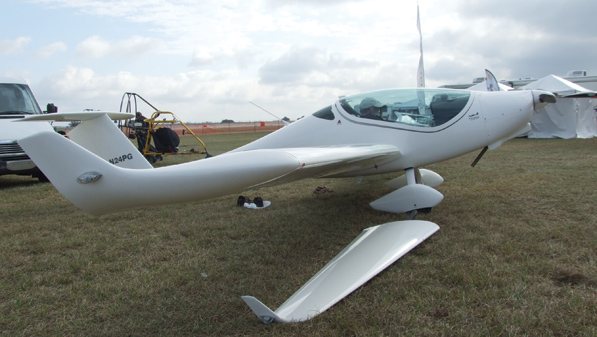
Jim Lee is importing a slick new motorglider, the all-carbon Phoenix, from the Czech Republic. With the easily removed wingtips installed, span is 49 feet.
Gliding back to the pattern at Sebring, we started the engine (which unfeathered the prop), set flaps to the 10 maximum, and I unlocked the spoilers and tried them. Failing to sufficiently follow Lee’s advice for touchdown, I reached the runway before achieving three-point attitude. The result: five landings for a one-landing attempt. (A flight review on Lee’s web site indicates an easier landing with no flaps, but that’s no excuse.)
Now, about that automatic prop feathering: LSAs are prohibited from having variable-pitch propellers, but motorgliders obviously need feathering capability. Thus the FAA incorporated an exception for them. However, someone inserted the term autofeathering (for which there is no FAA definition, Lee says). To get approved as an SLSA, the Phoenix was required to include an electric/mechanical feature that would feather when the engine was stopped and unfeather when it was restarted. But there is a safety problem. If the auto system fails to unfeather, the aircraft becomes a true glider, forcing a landing. The temporary solution in the Phoenix is a large lever that can override a failed auto featherer. But the permanent solution is that the FAA has removed part of a word (auto) from the feather/unfeather requirement. Lee has sold three Phoenix positions and has ordered half of the two-per-month factory production. They won’t include the autofeather gadget.
A final note is that the 49-foot width can be reduced to a more hangar-friendly 36-foot span in less than 2 minutes by removing the wingtips. Flightworthy short tips, complete with running lights and flaperon extensions, are a $1300 option. Lee says the shortened Phoenix flies like a pylon racer. The basic aircraft with round gauges, a Magnum ballistic ‘chute, a Becker com radio, and a boom mic and speaker for long glider flights is $149,000. Options include flat-panel displays, GPS and a fancy variometer (fast and sensitive VSI).
Flight No. 2. Sampled quite briefly was the waterbird version of the popular Flight Design CTLS. I flew with Tom Gutmann Jr. from the airport to Jackson Lake at Sebring. Performance and handling with the Clamar Composite amphibious floats were as I would expect. Rate of climb was close to 450 fpm, and full maximum-continuous power (5500 rpm from the 100-hp Rotax engine) indicated close to the 113-knot claimed speed.
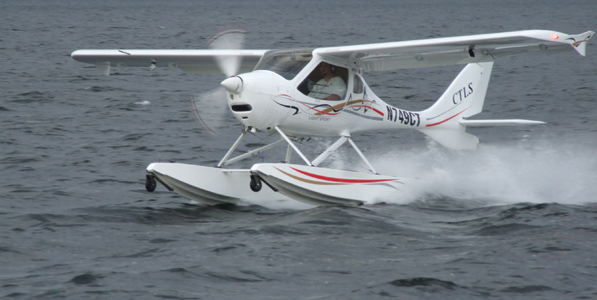
Flight Design’s CTLS was not new to the show, but the amphib version was.
One objective was photography on the water in the takeoff mode, so we looked for a low dock on Jackson Lake so I could get out with the camera. Not finding a dock low enough for a graceful exit and reentry, we beached the airplane and I walked to the end of a nearby dock. Gutmann made several high-speed taxi passes in the choppy water, and you see the result here. Whitecaps were beginning to form, and wave heights were already more than a foot, so I kept hands in lap as Gutmann horsed the airplane into the air after the photo session.
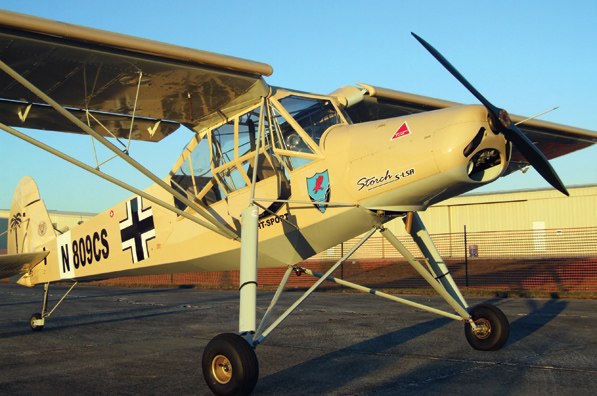
The Criquet Aviation USA Storch is among the latest to receive its FAA SLSA certificate.
Flight No. 3. The third flight, on the last morning, was planned to get out and back in the Criquet Aviation USA SLSA Storch (Stork), before the 9 o’clock control tower opening. The Criquet Storch is a scaled-down version of the famous German WW-II observation plane and airborne staff car. As in the other two aircraft flown on this Sebring visit, power was from a 100-hp Rotax 912 ULS, which seemed adequate for the Storch’s weight and size, including its 172-square-foot, 34.7-foot wing. Criquet parts are imported from Colombia, and they are assembly is in DeLand, Florida.

The Storch cockpit: shades of a 1930s dirigible control room? No, airships didn’t have control sticks.
Flying in the back seat, with Tom Flesher in the front, I found that I could not see a single instrument. Gusty conditions would have precluded meaningful indications such as climb rate anyway, so I flew only to get a feel for the controls. Stick and rudder are neither stiff nor light throughout the airspeed range. The crank and bicycle chain flap-setting system (reached from the front seat only) is interesting, but everything else seemed normal for a taildragger LSA. The long shock-absorbing maingear legs and a big coil spring on the telescoping tailwheel system help get the Storch back on the ground gracefully. Along with its new SLSA certificate, the Criquet Storch offers choices for those who would rather build first, then fly. Kits will be available for both an Experimental LSA (100-hour build time) and an Experimental/Amateur-Built category project. In both kits, all of the welding is completed by the factory.
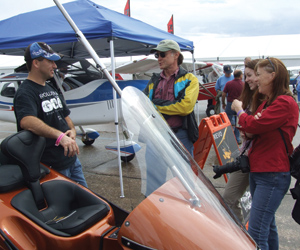
The owner of this trike described the fun he expects to have flying it when his new wing arrives.
Wrapping Up
Cessna again displayed a customer’s SkyCatcher LSA but did not offer journalists or customers (current or potential) demo flights. With a lengthy back-order list, Cessna appears to be concentrating on deliveries.
Paul Mather’s two M-Squared two-seat SLSAs, based on FAA-approved two-seat ultralight trainers, were displayed again and flew. Mather notes that his two-seaters offer one of the few legal and safe ways to get ultralight-style training from an appropriately rated flight instructor. The ready-to-fly planes sell for $35,000, and flight with a CFI builds time for higher ratings as it would in the faster, heavier SLSAs. M-Squared still offers single-seat ultralights for $15,000.
My annual check-in with event director Bob Wood confirmed that this year’s Expo was another success. Wood continues to be impressed by the enthusiasm of the vendors, his 200+ volunteers and the public. He hosted AOPA President Craig Fuller’s first Expo visit. Also, Wood recently attended the Popular Rotorcraft Association’s annual event, Bensen Days, and PRA reps checked out Expo 2011. Several gyroplanes flew into Sebring for this year’s show, and Wood said PRA expects to make a major appearance at Expo 2012.
A major storm delayed some Expo vendors, most notably RANS Aircraft, which didn’t get away from its Hays, Kansas, base until Friday. All of the spaces in the new large exhibitor tent were sold, and all but a few made the scene. Wood said that one headset retailer ran out of stock by Saturday and took orders for later delivery. He believes that the LSA category is maturing quickly and notes that the great winnowing of LSA manufacturers predicted for the last five years has not occurred; most of these companies are still in business.
Once again, the scheduling of next year’s U.S. Sport Aircraft Expo is being postponed until dates for early 2012 races are set by the Sebring International Speedway, which adjoins Sebring Airport. The idea is to not conflict with the crowds and noise produced by long-duration races on the famous twisty track. Which brings me to my choice of a rental car this year. I of course chose a Chrysler Sebring. Check the Sebring Airport web site for next year’s date.

![]()
Dave Martin served as editor of this magazine for 17 years and began aviation journalism evaluating ultralights in the early 80s. A former CFI (airplanes, gliders, instruments), hes flown more than 160 aircraft types plus 60 ultralights (including a single-seat, no-basket hot air balloon). Now living at a residential airpark in Oregon, he flies his new Vans Aircraft RV-12.


